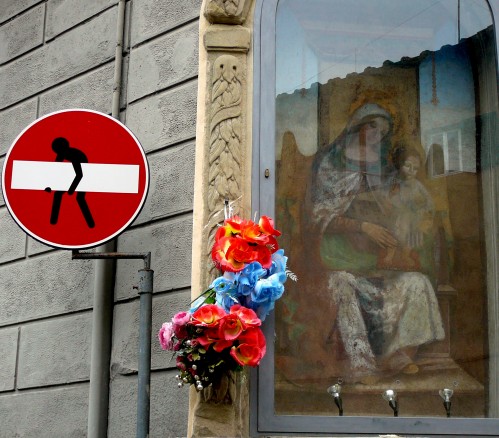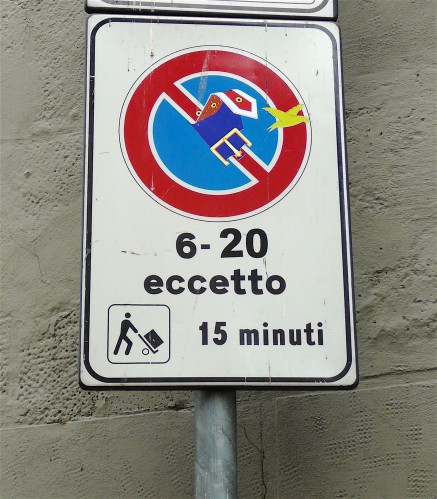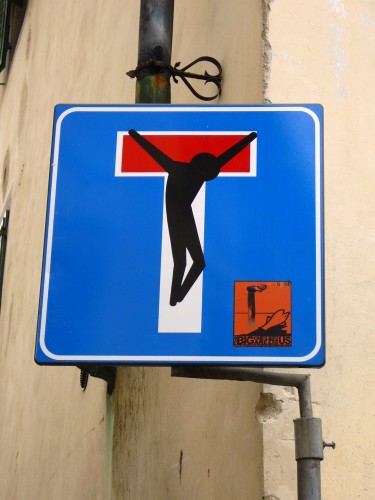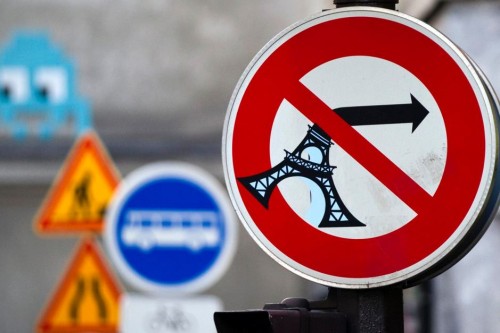I hate graffiti. I especially hate graffiti on the ancient Florentine walls. I want to hang the idiot, who keeps painting YOGURT on the walls in my neighborhood, up by some painful part of his anatomy. I especially want to throw away the key when the paint is on stonework or frescos created over 500 hundred years ago and can’t be cleaned off or painted over. So I was perfectly willing to condemn all street “artists” in Florence.

Until now. Well not exactly now. I giggled at this artist’s whimsical street sign work a year or so ago. And then he graced Ponte alle Grazie with the most imaginative sculpture (subject of another post). It was only when I got up close with his art on the walls of the innovative café/gallery La Buchetta that I was willing to say “he may be a street artist, but …”
His name? Clet. Where did he come from? France. Underlying philosophy? “As long as there are roads, there will be street art.”

Cletus Abraham is not exactly your everyday street artist. He was born in 1966 in Brittany. His father is the French writer Jean-Pierre Abraham. Clet attended the Ecole des Beaux-Arts in Rennes. His art was exhibited at various galleries of Brittany, after which he moved to Rome where he worked as a restorer of antique furniture. He exhibited in numerous galleries in Rome and Paris. In 2005, he moved to Florence. Did his arte nella strada begin here? I don’t know.
In 2010, the blogs started to twitter about Clet’s nighttime raids on Florence street signs. Clet said that he suddenly saw the overwhelming banality and primitiveness of the ubiquitous municipal signs that rule our lives. He wanted to give them another meaning — a political, religious and philosophic interpretation — without obscuring the readability of the underlying sign.

It began with a crucified Christ hanging from a “dead-end” sign. Then Da Vinci’s Vitruvian Man graced a “no-entry” sign. But the favorite has to be the Common Man who is carrying away the “no entry” bar.
Unlike the taggers and the spray painted ugliness on Florence’s ancient walls, Clet’s street sign art is a removable adhesive silhouette. His work can be found in Rome, Florence, Paris, Turin, London and Valencia. It may be coming to a city near you.

Alexandra Korey, of ArtTrav.com fame has already asked the question that most interested me: “What is the difference between your work and graffiti?” Clet answered:
I’m not sure exactly what the fundamental difference is between a graffiti artist and my work. I can say for sure that my stickers are easily removable. It’s essential to me to create works that are thematically in keeping with the support upon which I am working, to adapt myself thus to any situation with complete respect for the work of others; I try to offer a service with my talent and knowledge. It’s possible that some graffiti artists have a similar work ethic. We do have in common a taste for the mysteries of the night and of surprise; a healthy attitude [or preference] for liberty of expression and breaking of rules – but these are the bases of being an artist!
I may be persuaded that street art, when done well is a gift to the city and its residents, especially that which is not permanent or destructive, like the Clet street signs.

For Clet, street art is more of a hobby than a vocation. His works are experiencing a notable success with private collectors in Paris, Monte Carlo, and New York. Many private entities, such as Banca Popolare dell’Etruria e del Lazio, the Istituto Tommaso Crudeli of Udine and the Castello di Poppi, have commissioned works from him. He participated in three exhibitions organized by the FuoriLuogo (“Out of Place”) between 2008 and 2010.
You can visit his studio in Via dell’Olmo, 8r in the San Niccoló neighborhood where he sells small items (stickers, t-shirts, and pins) based on his work, as well as his enhanced city street signs, both new and weatherworn, discarded by the Florence road works department.
Check out the videos of Clet and his work.
